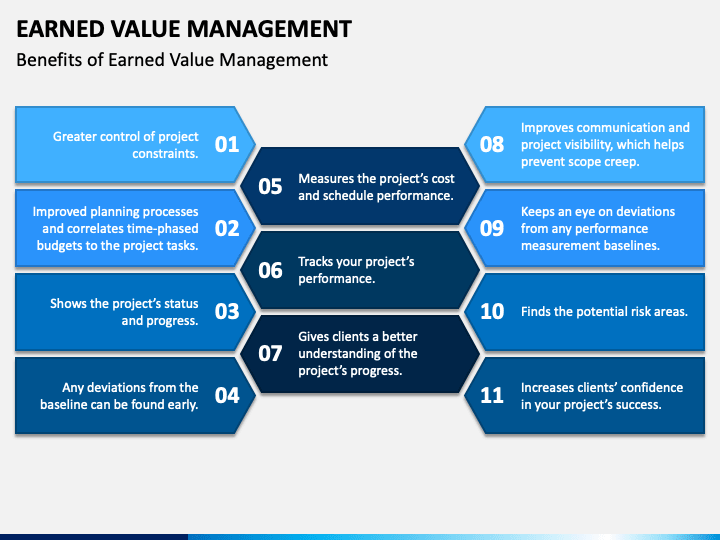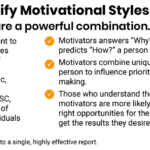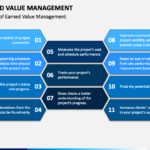
In today’s competitive business environment, project managers must manage cost, schedule, and performance effectively to ensure project success. One powerful tool for measuring and controlling the overall project performance is Earned Value Management.
EVM provides project managers with valuable insights into the status and trends of their projects. It enables them to make better decisions, communicate effectively with stakeholders, and address potential risks early on.
Project managers should know EVM’s potential challenges and limitations and address them head-on with a well-prepared implementation strategy. This Project Managers’ Guide will include insights into implementing and reaping the benefits of EVM in various project settings.
What is Earned Value Management (EVM) and Its Key Parameters?
Earned Value Management (EVM) stands as a crucial methodology in the field of project management. It offers a systematic and quantified approach to measuring a project’s performance and progress.
EVM facilitates decision-making by integrating critical aspects such as scope, time, and cost. It ensures better accountability at every stage of a project’s life cycle.
Initially developed in the 1960s by the United States Department of Defense, EVM has since evolved into a global best practice. Today, various industries, including construction, information technology, and aerospace, utilize this effective performance management tool to optimize project outcomes.
Three Key Parameters of EVM
EVM operates on three key parameters: Planned Value (PV), Actual Cost (AC), and Earned Value (EV). Planned Value represents the anticipated cost of completing a project’s work activities within the stipulated schedule.
Actual Cost, on the other hand, refers to the real expenses incurred during the execution of these activities. Earned Value denotes the worth of completed work and assesses the project’s performance.
Earned Value Management (EVM): 6 Benefits
EVM is a widely recognized project management methodology that integrates cost, scope, and schedule performance. It enables effective project performance monitoring and control. Employing EVM offers project managers and stakeholders data-driven insights into the true status of a project.
1. Improved Project Performance Measurement
Earned Value Management (EVM) offers a comprehensive approach to evaluating project performance. It allows project managers to make informed decisions and implement effective strategies. EVM ensures project managers understand their current status clearly instead of relying on subjective opinions or estimations.
For performance measurement, EVM identifies project performance issues early in the process. This early detection allows project managers to address potential problems before they escalate, thus increasing the overall success rate of the project.
EVM enables effective performance tracking by consistently monitoring progress across project phases and activities. This consistent tracking helps maintain focus on project objectives and drives continuous improvement.
It also supports forecasting future performance by generating reliable data on project trends and patterns. By analyzing this information, managers can make informed predictions about project outcomes and make necessary adjustments to keep the project on track.
This proactive approach to project management reduces the likelihood of project failure and increases the likelihood of successful project completion.
2. Enhanced Cost Control and Management
Cost management is a crucial aspect of project management, and EVM provides various tools to assist project managers in maintaining control over project costs. With accurate and reliable cost data, project managers can make more informed decisions about resource allocation and budget control.
Tracking and controlling project budgets becomes much easier with EVM, as it offers clear visibility into the cost performance of each project activity. By analyzing cost variances, project managers can quickly identify areas where costs exceed estimates and take corrective measures to prevent future overruns.
This proactive approach to cost management helps ensure that projects stay within their approved budgets, which is essential for overall project success.
EVM’s ability to monitor resource usage and track costs also facilitates the efficient allocation of resources. Project managers can optimize their allocations to achieve the best results within budget constraints by understanding which resources are underutilized or overutilized.
3. Better Schedule Control and Management
Effective schedule management is critical for the success of any project. EVM provides a systematic approach to tracking and controlling project schedules.
By measuring project progress against established timelines, project managers can easily identify potential schedule delays. He can take the necessary actions to mitigate them.
EVM encourages proactive schedule management, allowing project managers to allocate resources more efficiently and foresee potential bottlenecks. This level of foresight contributes to the overall success of a project by reducing time delays and associated costs.
It provides visibility into schedule dependencies, making it easier to understand how delays in one project activity could impact the progress of other activities. This visibility enables project managers to make well-informed decisions when rescheduling tasks and reallocating resources.
4. Improved Risk Management
Project risks can significantly derail your schedule, budget, and project outcome. EVM ensures you’re aware of these threats before they do damage, giving you time to devise a plan for success.
Project managers can prevent disruption and maximize the success of their projects by staying one step ahead with EVM. This smart strategy equips them to anticipate threats, quickly create solutions for any problems, and establish a strong basis in risk management. It results in better project outcomes.
EVM is a powerful tool that project managers can use to make smart, informed decisions when unexpected risks arise. It offers clear data-backed insights into your projects’ cost, schedule, and scope so you can nimbly adjust as needed for success.
With the right collaboration, teams can develop strategies to identify potential issues and create solutions that protect against major setbacks. Centralizing everyone’s knowledge creates better awareness for tackling risks head-on, giving projects much-needed stability in uncertain times.
5. Facilitation of Project Scope Management
Keeping a project on track is like running an obstacle course. Without Earned Value Management, you could be swerving beyond your scope, smashing into budget overages, or blowing right past deadlines without knowing it.
But with the help of EVM’s systematic approach, keeping that project moving in the right direction gets much easier.
EVM allows project managers to effectively manage scope change requests by providing valuable insights into the impacts of these changes on project costs and schedules. With this information, project managers can decide whether to approve the change, negotiate with stakeholders, or adjust the project plan accordingly.
The use of EVM also enables project teams to track scope changes throughout the project lifecycle. Project managers maintain a comprehensive record of all scope changes and their implications. He ensures that new requirements are appropriately integrated without compromising the original project goals by
EVM helps project managers evaluate the overall impact of scope changes on project success. It determines whether adjustments to the budget or schedule are required to accommodate the changes. This comprehensive overview ensures the best possible outcome for the project and its stakeholders.
6: Enhanced Project Communication and Reporting
Effective communication and reporting are crucial aspects of project management, and EVM offers practical tools for streamlining these processes. It provides objective reporting tools, facilitates communication among team members and key stakeholders, and generates a consistent, clear picture of project performance.
Improved stakeholder communication and awareness are other benefits of EVM. It promotes transparency by offering regular status updates and insights into project performance. This transparency helps build trust and rapport among stakeholders and enables productive discussions regarding project progress and possible issues.
EVM-generated reports also serve as essential decision-making tools for project teams. It presents accurate and up-to-date information on project costs, schedules, and scope changes. This wealth of data supports timely and informed decisions to ensure the project stays on track and within the agreed-upon parameters.
Boost Project Success with Earned Value Management
EVM is a crucial tool for project managers striving to ensure project success by meeting agreed-upon objectives within budget constraints and deadlines. Adopting EVM as part of your project management toolkit can increase efficiency, better resource allocation, and a deeper understanding of project performance trends.
Ultimately, the successful application of EVM can achieve project goals and exceed stakeholders’ expectations while maintaining cost and schedule control.
With its quantitative approach to cost and schedule management, EVM facilitates improved decision-making, forecasting, and reporting while also enabling clear communication with project stakeholders.



